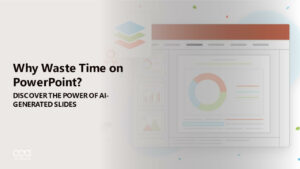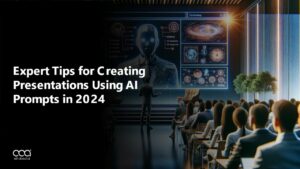In the quiet corners of our world, a revolution is unfolding. Artificial Intelligence (AI) is gently weaving its way into the fabric of healthcare, not as an overpowering force but as a compassionate ally in our ongoing battle for better health.
This transformation is backed by impressive AI statistics for 2024, which project a booming market expected to grow from $20.9 billion to a staggering $148.4 billion by 2029. (Source: marketsandmarkets)
As AI technology continues to evolve, it’s becoming an indispensable tool in medical settings, enabling healthcare professionals to make more accurate decisions faster than ever before.
Let’s explore in numbers how AI is making waves in the healthcare industry and the promising future it holds.
Here are important AI in healthcare statistics that will show the development in this sector.
AI in Healthcare Statistics for 2024: Highlights
By 2029, the healthcare AI market is poised to soar to nearly $150 billion. The exponential growth trajectory of AI in healthcare is projected to continue unabated.
By 2025, AI is anticipated to slash healthcare expenditures by $13 billion through heightened efficiency, minimized errors, and bolstered preventive care.
The AI-driven robot-assisted surgery market is set to hit $40 billion by 2026, with robots offering precision, mitigating human error, and potentially accelerating patient recovery times.
By 2025, an estimated 90% of hospitals are projected to integrate AI into their operations, marking a significant transition toward data-driven, efficient, and patient-centric healthcare practices.
With 79% of healthcare professionals optimistic about AI and robotics, it highlights their recognition of the industry’s potential benefits.
AI in Healthcare Market Value Growth Statistics From 2023 Onward
The market value is projected to increase significantly:
- 2023: The total market value was around USD 14.5 billion.
- 2024: The market value rises to approximately USD 20.9 billion.
- 2029: By the end of the forecast period, the market is expected to reach around USD 148.4 billion.

The AI in the healthcare market is projected to grow with an upward trend, expected to be $150 billion by 2029.
1. 58% Revenue Share in the Global AI Healthcare Market
The U.S.’s substantial 58% revenue share indicates a strong concentration of AI development and deployment within the country.
This leadership position is supported by robust healthcare infrastructure, significant investment in research and development, and a regulatory environment that is increasingly adapting to integrate and support AI technologies in healthcare. This dominance not only fuels innovation within the U.S. but also sets benchmarks globally.

Even when compared to the rest of the world, the US still has a higher revenue share in the AI healthcare market, capturing almost 60% of the global market.
Efficiency and Cost Reduction Statistics by AI in Healthcare for 2024
2. $13 Billion Reduction in Healthcare Costs by 2025
AI and machine learning are projected to help reduce healthcare costs by $13 billion by 2025. Cost reductions are expected from improved efficiency, reduced errors, and enhanced preventive care, illustrating AI’s significant financial impact on the healthcare system.
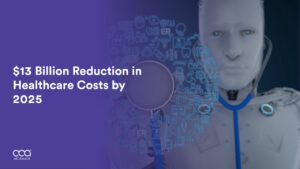
3. AI-driven Chatbots Saving $3.6 Billion Globally
AI-driven chatbots are poised to redefine patient interaction and service delivery, offering 24/7 assistance, handling routine inquiries, and providing consistent patient engagement. These savings stem from decreased labor costs and increased efficiency, allowing healthcare providers to allocate resources to more critical areas, thus enhancing overall service quality.
4. 70% Cost Reduction in Drug Discovery
AI’s impact on the pharmaceutical industry is particularly significant, with the potential to reduce the costs associated with drug discovery by up to 70%. AI enhances the efficiency of the drug development process by enabling faster and more accurate analysis of data, thus reducing both the time and resources needed to bring new drugs to market.
This cost efficiency not only accelerates the development of new treatments but also makes it economically viable to explore medications for less common diseases, potentially leading to groundbreaking treatments.
5. $16 Billion Savings from Reducing Medication Dosing Errors
AI’s ability to analyze and monitor medication dosing can significantly reduce errors, which are a major cause of concern in healthcare. These savings highlight AI’s role in enhancing patient safety and reducing avoidable healthcare costs associated with medication errors, such as adverse drug reactions and prolonged hospital stays.
6. Reduction of Physicians’ Administrative Tasks by 20%
The implementation of AI in healthcare has significantly lightened the administrative load on physicians by about 20%. This reduction allows doctors to spend more time on patient care rather than paperwork, leading to improved patient interactions and care quality. AI automates routine tasks such as scheduling, data entry, and patient follow-ups, enhancing overall operational efficiency.
7. Predictive AI Tools Could Reduce Hospital Admissions by Half
Predictive AI tools represent a major advancement in healthcare, with the potential to reduce hospital admissions by up to 50%. These tools analyze vast amounts of health data to predict patient health events before they occur, allowing for preemptive medical intervention.
This not only has the potential to reduce the strain on hospital resources significantly but also improves patient outcomes by preventing severe health episodes before they require emergency care. This proactive approach to healthcare, facilitated by AI, could fundamentally change how patient care is managed, making healthcare systems more efficient and responsive.
My Take on Efficiency and Cost Reduction Statistics by AI in Healthcare
I personally think each of these above-mentioned stats underscores the transformative potential of AI in healthcare, vividly illustrating the vast opportunities as well as the significant challenges associated with integrating advanced technologies into this crucial sector.
While the focus here is on the broader impact of AI in healthcare, identifying the best AI productivity tools in 2024 for medical professionals will be crucial for streamlining workflows and maximizing the efficiency of these advancements.
I am particularly intrigued by AI’s ability to reduce healthcare costs while simultaneously improving patient outcomes. This could fundamentally change the economic landscape of healthcare, making high-quality care more accessible to a broader segment of the population.
As I delve deeper into the implications of these advancements, I am both excited and cautiously optimistic about what the future holds, especially with the potential of AI to optimize healthcare delivery through these innovative tools.
Clinical and Diagnostic Improvements Statistics Resulting From AI in Healthcare for 2024
8. $40 Billion Robot-assisted Surgery Market by 2026
The expected growth in the robot-assisted surgery market reflects technological advancements and the increasing acceptance of these systems for complex surgeries. Robots provide precision, reduce human error, and can lead to quicker patient recovery times, contributing to their rising popularity and subsequent market growth.
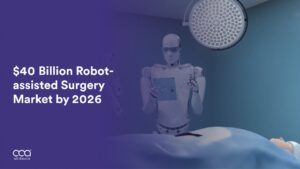
9. 26.5% CAGR in AI-integrated Medical Imaging (2021-2028)
This significant growth rate demonstrates the rapid incorporation of AI in enhancing the quality and speed of medical imaging. AI algorithms are increasingly used to detect anomalies earlier and with greater precision, contributing to better clinical decision-making and patient management.
10. 80% Accuracy in Predicting Cancer Patient Survival
AI models have achieved an 80% accuracy rate in predicting the survival outcomes of cancer patients. This high level of accuracy demonstrates AI’s potential in oncology to tailor treatment plans and predict patient trajectories, contributing to more personalized and effective care strategies.
11. Growth of AI in Precision Medicine by $14.5 billion
The expected market growth to $14.5 billion for AI in precision medicine by 2030 showcases its potential to revolutionize personalized healthcare. AI’s capability to process and analyze large-scale biometric data can lead to more accurate diagnoses, personalized treatment plans, and, ultimately, more effective outcomes for patients with complex or chronic conditions.
My Take on the Clinical and Diagnostic Improvements Statistics Resulting From AI in Healthcare
The projected growth in areas like robot-assisted surgery and AI-integrated medical imaging is incredibly promising. I find it particularly compelling how these advancements not only aim to enhance precision in treatments but also focus on reducing human error, which can be crucial in complex surgical scenarios.
Imagine the possibilities unlocked by utilizing the best AI video tools in 2024 alongside these advancements. I strongly believe that this commitment to precision and efficiency, coupled with the potential of AI video tools, could significantly enhance patient outcomes and recovery times, which is a remarkable step forward in healthcare.
AI Market and Technology Adoption Statistics in Healthcare for 2024
12. 20% of Healthcare Organizations Using AI
This adoption rate indicates that AI is becoming integral to healthcare operations, supporting everything from operational tasks to complex clinical decisions. The adoption is set to increase as more organizations witness the tangible benefits AI brings in improving efficiency, reducing costs, and enhancing patient care.
13. 34% of AI Apps in NHS Used for Diagnosis
In the NHS, 34% of AI applications are utilized for diagnostic purposes. This high percentage highlights the critical role of AI in enhancing diagnostic processes improving the accuracy and speed of identifying health conditions.
14. 90% of Hospitals to Employ AI by 2025
The widespread adoption of AI across hospitals signifies a shift towards more data-driven, efficient, and patient-centered healthcare. AI applications in early diagnosis and remote monitoring facilitate timely interventions, reduce the need for in-person visits, and enable continuous monitoring of chronic conditions, enhancing overall healthcare delivery.
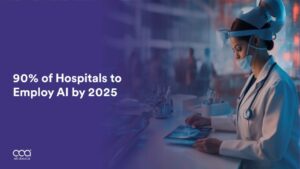
15. 10% of Medical Professionals Using AI Tools
Approximately 10% of medical professionals now use AI-powered tools like Med-PaLM2 or ChatGPT to enhance solution effectiveness. These tools assist in generating accurate patient responses, diagnosing, and even treatment planning, reflecting AI’s growing role in enhancing medical practice and patient interaction.
16. 23% of U.S. Healthcare Executives Acknowledge AI’s Efficacy
In the USA, 23% of healthcare executives believe that AI and machine learning greatly enhance clinical outcomes. This perception underscores AI’s potential to improve diagnostic accuracy, treatment efficacy, and patient management, ultimately leading to better healthcare delivery.
17. Human Role in Nursing Tasks by 2030
Despite advancements in AI, 90% of nursing tasks are expected to still be performed by humans by 2030. This statistic emphasizes the irreplaceable value of human touch, empathy, and judgment in nursing, underscoring that AI will augment rather than replace human roles in healthcare.
My Take on AI Market and Technology Adoption Statistics in Healthcare
From my perspective, the fact that currently, only one-fifth of healthcare organizations have implemented AI technologies highlights both the progress and the hurdles in the adoption of such innovations.
This slow adoption rate underscores the need for readily available resources and educational initiatives to guide implementation. Identifying the best AI tools in 2024 for specific needs, alongside clear best practices, would be a significant step towards wider adoption.
Personally, I find it inspiring to see early adopters leveraging AI to enhance efficiency, reduce errors, and improve patient outcomes. These advancements clearly illustrate AI’s capacity to transform healthcare fundamentally.
However, I also recognize the challenges that come with these innovations. It’s crucial, in my view, that we address these challenges head-on, ensuring that the adoption of AI technologies does not compromise patient privacy or become prohibitively expensive for smaller or less-resourced institutions. Only then can we truly unlock the full potential of AI in healthcare!
Public Perception and Professional Optimism Statistics of AI in Healthcare in 2024
18. 79% of Healthcare Professionals Optimistic About AI and Robotics
The high level of optimism among healthcare professionals reflects a recognition of the potential benefits that AI and robotics bring to the industry. This includes not only enhancing the quality of care but also alleviating some of the burdens on healthcare workers, leading to better work conditions and patient interactions.
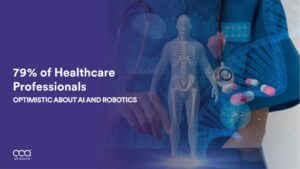
19. 60% of Americans Uncomfortable with AI in Healthcare
Despite the benefits, there is considerable public skepticism regarding AI in healthcare, with 60% of Americans uncomfortable with the idea of their healthcare providers relying heavily on AI.
This discomfort stems from concerns over privacy, the potential loss of human oversight, and a general distrust in machine-based decision-making. Addressing these concerns requires healthcare providers and AI developers to enhance transparency about how AI tools function and are integrated into healthcare delivery.
My Take on the Public and Professional Perception Statistics of AI in Healthcare
As someone deeply involved in this field, I feel a responsibility to advocate for policies and practices that will foster trust and confidence in AI technologies among the general public while continuing to harness their benefits to enhance healthcare delivery.
Global Artificial Intelligence in Healthcare Market by Geography for 2024
Here is the distribution of the AI in healthcare market share by region for the year 2024- 2029:
2024
- North America: 60% of the market, indicating it has the largest share.
- Europe: 20%, showing a significant market presence but much smaller compared to North America.
- Asia-Pacific: 15%, reflecting noticeable growth and a substantial market size.
- Rest of the World: 5%, the smallest share, but still contributing to the global market.

The distribution of AI in healthcare market share by region is shown; North America holds a staggering 60% share.
2029
- North America: Projects the largest share with significant growth, indicating strong continued investment and adoption of AI in healthcare.
- Europe: Substantial growth, maintaining a strong position but still less than North America.
- Asia-Pacific: Demonstrates the most rapid growth rate, significantly increasing its share by 2029.
- Rest of the World: Although starting from a smaller base, it shows growth, indicating the spreading adoption of AI technologies in healthcare markets outside the major regions.
North America will dominate the AI healthcare market by 2029, with Europe and Asia-Pacific also holding significant portions. The Rest of the World category, although the smallest, represents emerging markets that are starting to adopt AI in healthcare.
Projected Growth in Revenue for the Generative AI in Healthcare
There is a robust and accelerating growth trajectory for generative AI applications in the healthcare sector, suggesting increasing adoption and integration of these technologies in healthcare practices and systems over the next decade. Here are the key stats demonstrating the increase:
- Starting Point (2022): The revenue for generative AI in healthcare begins at approximately $1.070 million.
- Yearly Growth: Each subsequent year shows an increase in revenue, reflecting a positive growth trend in the market. Leveraging the best AI generator tools for 2024 can ensure this positive trend continues for you as well.
- Midway (2027): By 2027, the revenue is expected to reach approximately $4.820 million, showing a significant increase from the starting point.
- Rapid Increase: The growth in revenue becomes more pronounced in later years, with a notable jump after 2029.
- End of Projection (2032): By 2032, the revenue is projected to reach around $21.740 million, indicating a substantial expansion over the ten-year period.

Generative AI in Healthcare has an explosive growth trend, the projected market revenue by 2032 is expected to more than 10x that of 2024.
My Take on AI in Healthcare Statistics
I’m excited about the transformative impact of AI in healthcare. Statistics show this field is thriving and poised for explosive growth. But to unlock this potential, we need clear communication and well-structured educational materials. Here’s where the best AI writing tools in 2024 can be a game-changer.
Sure, some patients have privacy concerns. But professionals overwhelmingly agree that AI’s potential to cut costs, reduce bias, and improve patient outcomes is undeniable. Research even shows AI can outperform humans in analyzing symptoms and predicting outcomes. This is revolutionary, promising faster diagnoses, quicker recoveries, and less strain on healthcare systems as populations age.
AI’s impact goes beyond clinical care. Automating routine tasks in administration will free up doctors’ time for patients, not paperwork. This shift promises to drive efficiency and improve services across healthcare, making it not just bigger, but better.
FAQs
What percent of healthcare uses AI?
How is AI used in the healthcare industry?
Will AI take over healthcare?
References
| Statista | Statista – AI Adoption | Precedence Research |
| Harvard Business Review | Insider Intelligence | Grand View Research – AI Precision Medicine |
| Forbes | Pew Research | UBC |
| Nature Communications | – | – |


